For a long time typical project management has been done by project managers creating and maintaining plans, and controlling resources, scope and quality in order to complete projects. Usually these people work largely by themselves, without much collaboration from anyone else involved in the project – such as stakeholders and resources. For many reasons companies are now moving toward changes in methods that encourage greater collaboration for everyone involved in a project.
Most decision makers understand that a project should be thought of as an investment, so the primary motivation for this new methodology is financial considerations. Financial impact of project investments can be viewed differently, for example some may try to achieve higher resource utilization, or faster project completion. Other benefits include better visibility into current and future project costs in order to support decisions around project prioritization. Also, the quality of the project deliverables is a significant factor that can be influenced by a more collaborative approach. A significant business process reengineering initiative like this requires time and work; in other words, it is a big investment. Sadly the required investment and level of executive sponsorship are often miscalculate or overlooked, producing frustration or even failure.
I provide a high level view of some of the method transformations required when moving to a collaborative project management environment:
Traditional Project Management
- Project plans and schedules can be maintained in different formats using a different tools, such as Microsoft Project, Excel or even Word
- KPIs can be setup and tracked for a single project, but are difficult to reuse across projects or have different meanings based in the interpretation of various project teams
- Resource assignments are managed inside each individual project or not at all, but not across all projects in a consistent way
- While separate project plans may have common milestones those dependencies are not managed visibly or accountably
Enterprise Project Management
- Project plans and schedules are maintained using common templates with one centralized tool
- Key Performance Indicators are setup for all projects and groups of projects and set a universal meaning for the business
- Project resources are tracked in a single pool so that project and resource managers can see how resources high level utilization for all projects, as well being able to predict future resource requirements from planned investments
- Common milestones and deliverables can be managed in a visibly and accountably, giving decision makers a basis to understand the health, costs and schedule of the overall program
When considering a change to an enterprise project management methodology, all costs of the process change should be carefully understood, along with the potential benefits. In today’s economy, it is difficult to understate the potential gains from greater efficiency when making and managing project investments. The commitment necessary to achieve this efficiency must be balanced against those gains.
